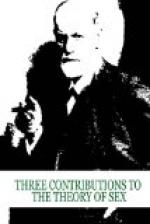The Paths of Opposite Influences.—(b) Since we are now dropping the figurative manner of expression hitherto employed, by which we spoke of sources of sexual excitement, we may now assume that all the connecting ways leading from other functions to sexuality must also be passable in the reverse direction. For example, if the lip zone, the common possession of both functions, is responsible for the fact that the sexual gratification originates during the taking of nourishment, the same factor offers also an explanation for the disturbances in the taking of nourishment if the erogenous functions of the common zone are disturbed. As soon as we know that concentration of attention may produce sexual excitement, it is quite natural to assume that acting on the same path, but in a contrary direction, the state of sexual excitement will be able to influence the availability of the voluntary attention. A good part of the symptomatology of the neuroses which I trace to disturbance of sexual processes manifests itself in disturbances of the other non-sexual bodily functions, and this hitherto incomprehensible action becomes less mysterious if it only represents the counterpart of the influences controlling the production of the sexual excitement.
However the same paths through which sexual disturbances encroach upon the other functions of the body must in health be supposed to serve another important function. It must be through these paths that the attraction of the sexual motive-powers to other than sexual aims, the sublimation of sexuality, is accomplished. We must conclude with the admission that very little is definitely known concerning the paths beyond the fact that they exist, and that they are probably passable in both directions.
[1] For it is really impossible to have a correct knowledge of the part belonging to heredity without first understanding the part belonging to the infantile.
[2] This assertion on revision seemed even to myself so bold that I decided to test its correctness by again reviewing the literature. The result of this second review did not warrant any change in my original statement. The scientific elaboration of the physical as well as the psychic phenomena of the infantile sexuality is still in its initial stages. One author (S. Bell, “A Preliminary Study of the Emotions of Love Between the Sexes,” American Journal of Psychology, XIII, 1902) says: “I know of no scientist who has given a careful analysis of the emotion as it is seen in the adolescent.” The only attention given to somatic sexual manifestations occurring before the age of puberty was in connection with degenerative manifestations, and these were referred to as a sign of degeneration. A chapter on the sexual life of children is not to be found in all the representative psychologies of this age which I have read. Among these works I can mention the following: Preyer; Baldwin (The Development of




